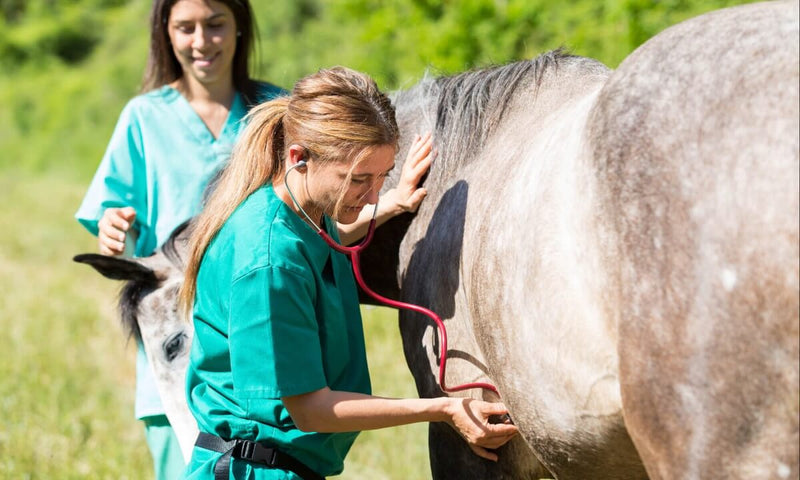Published: August 2020 | Updated: April 2024
Have you ever noticed that any time you go to the doctor, even if you’re seeing the dermatologist or eye doctor, the first thing the nurse and doctor do is take your temperature and blood pressure?
I’ve often found myself asking why. “I’m just here to have an eye exam…”
Well, vital signs are one of the most basic measures of essential body functions. And if your vital organs are struggling with essential functions, then it could point to some pretty serious issues.
The same goes for your horse! Regardless of what you call the vet for, the first thing they do is assess the animal’s vital signs.
The most commonly measured vital signs for any species are referred to as TPR: Temperature, Pulse (heart rate), and Respiration rate. You may not be taking your horse’s TPR every time you go out to the barn, but it is something to be aware of, especially in emergencies. This is why it is a good idea to have a thermometer and stethoscope on hand as tools in your barn supply kit.
Here’s what the normal temperature, heart rate, and respiratory rate ranges are for horses.
|
Temperature |
Pulse (Heart Rate) |
Respiration |
|
|
Adult |
99.0-101.0 degrees F |
28-44 beats/min |
8-16 breaths/min |
|
Foals/Weanlings |
99.0-102.0 degrees F |
70-110 beats/min |
20-40 breaths/min |
Horse TPR Tips
Temperature
A horse’s temperature can be taken easily with a rectal digital thermometer. Be sure to stand close to the horse’s side, be gentle when pushing their tail to the side and inserting the thermometer. And as with all things “horse,” stay calm and be patient. The wisdom that it is impossible to rush anything when it comes to horses applies here too.
Be careful that you measure this vital sign when the horse is relaxed. Just like humans, if they are running around their pasture excitedly or if you just rode them, their temperature will be higher and not indicative of “normal” horse temperature.
Even though the “T” comes first in the abbreviation, it’s a good idea to take temperature as the LAST vital sign. When you stick a thermometer up a horse’s rear, they might get slightly, understandably stressed, which could alter their heart and respiratory rate.
Pulse (Heart Rate)
Normal horse heart rate (or pulse) measures the number of times the heart beats in a minute. There are a few ways to measure a horse’s heart rate. For one, you can use a stethoscope on the left side of the horse’s body in the heartgirth area (behind their elbow), or you can use your fingers on the artery underneath their jaw or find the digital pulse on their legs. Press your finger firmly over the artery and experiment with the pressure you apply.
Regardless of how you measure pulse, it is standard to measure for 15 seconds and multiply by 4 to get beats per minute. In addition, remember that 2 “beats” or sounds, is equivalent to 1 counted beat. In other words, the “lub” and the “dub” equals 1 of your counted beats.
It’s good practice to measure pulse after respiration and before temperature.
Respiration
Normal respiration is the number of breaths per minute that a horse takes. To check a horse’s breathing rate, watch the flank, nostrils, or use your stethoscope on the trachea. It is easiest to watch the flank while they are at rest. One counted “respiration” is equal to one inhalation + exhalation. This means you will watch the flank rise and fall for one counted breath.
If you can, count respiration for 30 seconds (and multiply by 2) to 1 minute for a more accurate reading.
What Are the Normal Vital Signs For a Horse?
It is important to recognize that every horse is a little bit different. Practice taking your horse’s TPR to get an idea of what is normal for your furry friend and keep this information in your back pocket to spot a problem before it is serious.
Another equally important vital sign involves using the stethoscope to listen to gut sounds. Read more about that here.
Healthy horses are every horse lover’s priority. By paying attention to vital signs and other indicators of health, you will be able to notice problems sooner, before they become serious.
Subscribe to our newsletter here to stay informed of the latest and greatest in horse health news!


